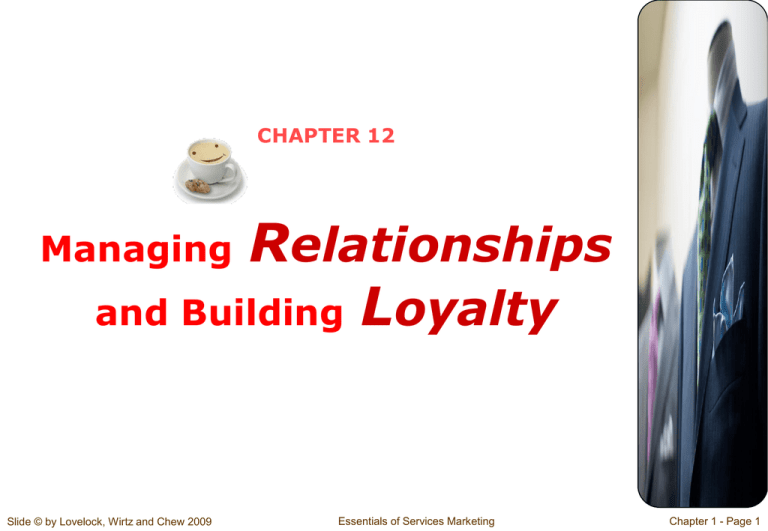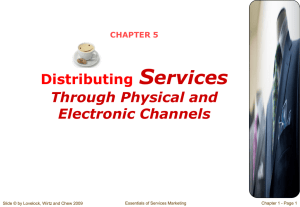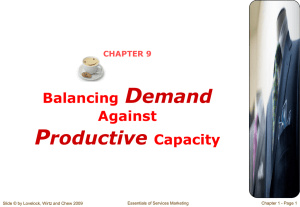Chapter 12
advertisement

CHAPTER 12 Relationships and Building Loyalty Managing Slide © by Lovelock, Wirtz and Chew 2009 Essentials of Services Marketing Chapter 1 - Page 1 Overview of Chapter 12 The Search for Customer Loyalty The Wheel of Loyalty Building a Foundation for Loyalty Strategies for Developing Loyalty Bonds with Customers Strategies for Reducing Customers Defections CRM: Customer Relationship Management Systems Slide © by Lovelock, Wirtz and Chew 2009 Essentials of Services Marketing Chapter 1 - Page 2 The Search for Customer Loyalty Slide © by Lovelock, Wirtz and Chew 2009 Essentials of Services Marketing Chapter 1 - Page 3 How Much Profit a Customer Generates Over Time (Fig 12.2) Slide © by Lovelock, Wirtz and Chew 2009 Essentials of Services Marketing Chapter 1 - Page 4 Why Is Customer Loyalty Important to A Firm’s Profitability? Customers become more profitable the longer they remain with a firm: Increase purchases and/or account balances - Customers / families purchase in greater quantities as they grow Reduced operating costs - Fewer demands from suppliers and operating mistakes as customer becomes experienced Referrals to other customers - Positive word-of-mouth saves firm from investing money in sales and advertising Price premiums - Long-term customers willing to pay regular price - Willing to pay higher price during peak periods Slide © by Lovelock, Wirtz and Chew 2009 Essentials of Services Marketing Chapter 1 - Page 5 Why Customers Are More Profitable Over Time (Fig. 12.3) Slide © by Lovelock, Wirtz and Chew 2009 Essentials of Services Marketing Chapter 1 - Page 6 Assessing the Value of a Loyal Customer Must not assume that loyal customers are always more profitable than those making one-time transactions Large customers may expect price discounts in return for loyalty Revenues don’t necessarily increase with time for all types of customers Tasks: Determine costs and revenues for customers from different market segments at different points in their customer lifecycles Predict future profitability Slide © by Lovelock, Wirtz and Chew 2009 Essentials of Services Marketing Chapter 1 - Page 7 Measuring Customer Equity: Lifetime Value of Each Customer Acquisition revenues less costs Revenues (application fee + initial purchase) Costs (marketing +credit check + account set up) Projected annual revenues and costs Revenues (annual fee + sales + service fees + value of referrals) Costs (account management + cost of sales + write-offs) Value of referrals Percentage of customers influenced by other customers Other marketing activities that drew the firm to an individual’s attention Net Present Value Sum anticipated annual values (future profits) Suitably discounted each year into the future Slide © by Lovelock, Wirtz and Chew 2009 Essentials of Services Marketing Chapter 1 - Page 8 Why are Customers Loyal? (1) (Service Insights 12.1) Customers stay loyal when we create value for them Value can be created for customers through Confidence benefits - Confidence in correct performance - Ability to trust the provider - Lower anxiety when purchasing - Knowing what to expect and receive Slide © by Lovelock, Wirtz and Chew 2009 Essentials of Services Marketing Chapter 1 - Page 9 Why are Customers Loyal? (2) (Service Insights 12.1) Social benefits - Mutual recognition and friendship between service provider and customer Special treatment - Better price - Discounts not available to most customer - Extra services - Higher priority when there is a wait Slide © by Lovelock, Wirtz and Chew 2009 Essentials of Services Marketing Chapter 1 - Page 10 The Wheel of Loyalty Slide © by Lovelock, Wirtz and Chew 2009 Essentials of Services Marketing Chapter 1 - Page 11 The Wheel of Loyalty Slide © by Lovelock, Wirtz and Chew 2009 (Fig. 12.5) Essentials of Services Marketing Chapter 1 - Page 12 Building a Foundation for Loyalty Slide © by Lovelock, Wirtz and Chew 2009 Essentials of Services Marketing Chapter 1 - Page 13 Targeting the Right Customers and Searching for Value, Not Volume Target the right customer and match them to what firm can deliver How do customer needs relate to operations elements? How well can service personnel meet expectations of different types of customers? Can company match or exceed competing services that are directed at same types of customers? Focus on number of customers served as well as value of each customer Some customers more profitable than others in the short term Others may have room for long-term growth “Right customers” are not always high spenders Can come from a large group of people that no other supplier is serving well Slide © by Lovelock, Wirtz and Chew 2009 Essentials of Services Marketing Chapter 1 - Page 14 Effective Tiering of Service The Customer Pyramid (Fig 12.7) Slide © by Lovelock, Wirtz and Chew 2009 Essentials of Services Marketing Chapter 1 - Page 15 The Customer Satisfaction Loyalty Relationship (Fig. 12.9) Slide © by Lovelock, Wirtz and Chew 2009 Essentials of Services Marketing Chapter 1 - Page 16 Strategies for Developing Loyalty Bonds with Customers Slide © by Lovelock, Wirtz and Chew 2009 Essentials of Services Marketing Chapter 1 - Page 17 Strategies for Developing Loyalty Bonds with Customers (1) Deepening the relationship Bundling/Cross-selling services makes switching a major effort that customer is unwilling to go through unless extremely dissatisfied with service provider Customers benefit from buying all their various services from the same provider - One-stop-shopping, potentially higher service levels, higher service tiers etc Slide © by Lovelock, Wirtz and Chew 2009 Essentials of Services Marketing Chapter 1 - Page 18 Strategies for Developing Loyalty Bonds with Customers (2) Reward Based Bonds Can be financial or non-financial bonds or a combination of both Financial bonds - Discounts on purchases, loyalty program rewards (e.g. frequent flier miles), cash-back programs Non-financial rewards - Priority to loyalty program members for waitlists and queues in call centers; higher baggage allowances, priority upgrading, access to airport lounges for frequent flyers Intangible rewards - Special recognition and appreciation Reward-based loyalty programs are relatively easy to copy and rarely provide a sustained competitive advantage Slide © by Lovelock, Wirtz and Chew 2009 Essentials of Services Marketing Chapter 1 - Page 19 Strategies for Developing Loyalty Bonds with Customers (3) Social Bonds Based on personal relationships between providers and customers Harder to and takes a longer time to build, but also harder to imitate and thus, better chance of retention in the long term Customization Bonds Customized service for loyal customers - e.g. Starbucks Customers may find it hard to adjust to another service provider who cannot customize service Slide © by Lovelock, Wirtz and Chew 2009 Essentials of Services Marketing Chapter 1 - Page 20 Strategies for Developing Loyalty Bonds with Customers (4) Structural Bonds Mostly seen in B2B settings Align customers way of doing things with supplier’s own processes - Joint investments in projects and sharing of information, processes and equipment. Can be seen in B2C environment too - Airlines - SMS check-in, SMS email alerts for flight arrival and departure times Difficult for competition to draw customers away when they have integrated their way of doing things with existing supplier Slide © by Lovelock, Wirtz and Chew 2009 Essentials of Services Marketing Chapter 1 - Page 21 Strategies for Reducing Customer Defections Slide © by Lovelock, Wirtz and Chew 2009 Essentials of Services Marketing Chapter 1 - Page 22 Analyze Customer Defections and Monitor Declining Accounts Understand reasons for customer switching Churn Diagnostics common in mobile phone industry Analysis of data warehouse information on churned and declining customers Exit interviews: - Ask a short set of questions when customer cancels account; in-depth interviews of former customers by third party agency Slide © by Lovelock, Wirtz and Chew 2009 Essentials of Services Marketing Chapter 1 - Page 23 What Drives Customers to Switch? (Fig 12.9) Slide © by Lovelock, Wirtz and Chew 2009 Essentials of Services Marketing Chapter 1 - Page 24 Address Key Churn Drivers Deliver quality service Reduce inconvenience and non-monetary costs Have fair and transparent pricing Industry specific drivers Cellular phone industry: handset replacement a common reason for subscribers discontinuing services – offer handset replacement programs Take active steps to retain customers Save teams: specially trained call center staff to deal with customers who want to cancel their accounts Be careful about how save teams are rewarded (see Service Insights 12.5) Slide © by Lovelock, Wirtz and Chew 2009 Essentials of Services Marketing Chapter 1 - Page 25 Other Ways to Reduce Churn Implement Effective Complaint Handling and Service Recovery Procedures Increase Switching Costs Natural switching costs - e.g. Changing primary bank account – many related services tied to account Can be created by instituting contractual penalties for switching - Must be careful not to be perceived as holding customers hostage - High switching barriers and poor service quality likely to generate negative attitudes and bad word of mouth Slide © by Lovelock, Wirtz and Chew 2009 Essentials of Services Marketing Chapter 1 - Page 26 CRM: Customer Relationship Management Systems Slide © by Lovelock, Wirtz and Chew 2009 Essentials of Services Marketing Chapter 1 - Page 27 Common Objectives Of CRM Systems (1) Customer perspective Unified customer interface that delivers customization and personalization Vast service improvement and increase customer value Company perspective Better segment, tier customer base and target promotion Implement churn alert systems if customers are in danger of defecting Slide © by Lovelock, Wirtz and Chew 2009 Essentials of Services Marketing Chapter 1 - Page 28 Common Applications Of CRM Systems (1) (Service Insights 12.6) Data collection Customer data such as contact details, demographics, purchasing history, service preferences, and the like Data analysis Data captured is analyzed and categorized Used to tier customer base and tailor service delivery accordingly Sales force automation Sales leads, cross-sell and up-sell opportunities can be effectively identified and processed Entire sales cycle from lead generation to close of sales and aftersales service can be tracked and facilitated through CRM system Slide © by Lovelock, Wirtz and Chew 2009 Essentials of Services Marketing Chapter 1 - Page 29 Common Objectives Of CRM Systems (2) (Service Insights 12.6) Marketing automation Mining of customer data enables the firm to target its market Goal to achieve one-to-one marketing and cost savings, often in the context of loyalty and retention programs Results in increasing the ROI on its marketing expenditure CRM systems also allows firms to judge effectiveness of marketing campaigns through the analysis of responses Call center automation Call center staff have customer information at their finger tips and can improve their service levels to all customers Caller ID and account numbers allow call centers to identify the customer tier the caller belongs to, and to tailor the service accordingly - For example, platinum callers get priority in waiting loops. Slide © by Lovelock, Wirtz and Chew 2009 Essentials of Services Marketing Chapter 1 - Page 30 Comprehensive CRM Strategy Strategy Development Process Value Creation Process (Fig 12.14) Multichannel Integration Process Performance Assessment Process Information Management Process Source: Adapted from: Adrian Payne and Pennie Frow, “A Strategic Framework for Customer Relationship Management,” Journal of Marketing 69 (October 2005): 167-176. Slide © by Lovelock, Wirtz and Chew 2009 Essentials of Services Marketing Chapter 1 - Page 31 Integrated Framework for CRM Strategy Development Strategy Development Assessment of business strategy Business strategy guides development of customer strategy Slide © by Lovelock, Wirtz and Chew 2009 Essentials of Services Marketing Chapter 1 - Page 32 Integrated Framework for Strategy – Value Creation CRM Value Creation Translates business and customer strategies into specific value propositions for both customers and firm - Customers benefit from priority, tiered services, loyalty rewards and customization - Company benefits from reduced customer acquisition and retention costs, and increased share-of-wallet Dual creation of value: customers need to participate in CRM to reap value from firm’s CRM initiatives Slide © by Lovelock, Wirtz and Chew 2009 Essentials of Services Marketing Chapter 1 - Page 33 Integrated Framework for CRM Strategy – Multi-Channel Integration Multi-channel Integration Serve customers well across many potential interfaces Offer a unified interface that delivers customization and personalization Slide © by Lovelock, Wirtz and Chew 2009 Essentials of Services Marketing Chapter 1 - Page 34 Integrated Framework for CRM Strategy – Performance Assessment Performance Assessment Is CRM system creating value for key stakeholders? Are marketing and service standard objectives being achieved? Is CRM system meeting performance standards? Slide © by Lovelock, Wirtz and Chew 2009 Essentials of Services Marketing Chapter 1 - Page 35 Integrated Framework for CRM Strategy – Information Management Information Management Collect customer information from all channels Integrate it with other relevant information Make useful information available to the frontline Create and manage data repository, IT systems, analytical tools, specific application packages Slide © by Lovelock, Wirtz and Chew 2009 Essentials of Services Marketing Chapter 1 - Page 36 Common Failures in CRM Implementation Unfortunately, there is a high failure rate for CRM implementations Common reasons for failures Viewing CRM as a technology Initiative Lack of customer focus Not enough understanding of customer lifetime value (CLV) Inadequate support from top management Lack of coordination Failure to reengineer business processes Underestimating the challenges in data integration Slide © by Lovelock, Wirtz and Chew 2009 Essentials of Services Marketing Chapter 1 - Page 37 Key Issues in Defining a Customer Relationship Strategy How should our value proposition change to increase customer loyalty? How much customization or one-to-one marketing and service delivery is appropriate and profitable? What is the increase in profit from increasing share-ofwallet with current customers? How much does this vary by customer tier and/or segment? How much time and resources can we provide to CRM right now? If we believe in customer relationship management, why haven’t we taken more steps in that direction in past? What can we do today to develop customer relationships without spending on technology? Slide © by Lovelock, Wirtz and Chew 2009 Essentials of Services Marketing Chapter 1 - Page 38 Summary of Chapter 12: Managing Relationships and Building Loyalty (1) Customer loyalty as an important driver of profitability for service firms so firms need to Assess value of loyal customer Narrow gap between actual and potential customer value Wheel of Loyalty shows how firms can: Build a foundation of loyalty Create loyalty bonds Reduce churn drivers Building a foundation of loyalty involves Good fit between customer needs and capabilities Searching for value, not just volume Tiering services effectively Obtaining customer satisfaction through service quality Slide © by Lovelock, Wirtz and Chew 2009 Essentials of Services Marketing Chapter 1 - Page 39 Summary of Chapter 12: Managing Relationships and Building Loyalty (2) Customer loyalty bonds include Reward-based bonds Social bonds Customization bonds Structural bonds Strategies for reducing customer defections include Analyzing customer defections and monitoring declining accounts Addressing key churn drivers Implementing effective complaint-handling and service recovery procedures Increasing switching costs Slide © by Lovelock, Wirtz and Chew 2009 Essentials of Services Marketing Chapter 1 - Page 40 Summary of Chapter 12: Managing Relationships And Building Loyalty (3) Customer relationship management (CRM) is a whole process by which relations with customers are built and maintained. An integrated CRM system includes Strategy development process Value creation process Multichannel integration process Performance assessment process Cresting a successful CRM program requires understanding common failures in CRM implementation and knowing how to get it right Slide © by Lovelock, Wirtz and Chew 2009 Essentials of Services Marketing Chapter 1 - Page 41








